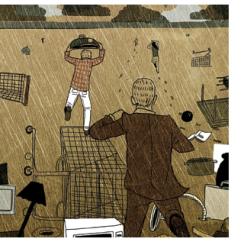All macro traders and most asset managers I know still believe they are living in a precarious risk-on, risk-off world. Their hard-won gains from clever carry trades or high-alpha stock picks can get washed out in an instant by a surprise statement from an equivocating Eurocrat or a belligerent ayatollah. They assume that RORO, as this phenomenon of highly correlated asset markets is known, is now an inescapable fact of life on the trading floor, an unpleasant yet persistent trend like global warming or reality TV.
Yet all macro traders know that implied volatility is trending down, in a series of successively lower waves of the VIX, the Chicago Board Options Exchange index of volatility in options prices on stocks in the S&P 500 index, since its peak in 2009. They also have the impression that markets are shrugging off bouts of volatility more quickly, but they’re not sure they trust this apparent reversion to stability.
“I’m anxious that the new normal may turn out to be a walk in a dark labyrinth,” says Mark Farrington, head of London-based Macro Currency Group, the currency specialist arm of U.S.-based Principal Global Investors. “On the surface the data suggest an ebb in volatility indicators and even a respite in risk-on, risk-off market conditions. But our research suggests that the true underlying risk to portfolios is not accurately reflected in the implied market volatility indexes.”
Have the political factors that drive financial markets changed in some fundamental way in recent years to produce this unnerving pattern of reduced volatility with elevated RORO, or have the markets themselves changed? The question has far-reaching implications for traders and investors around the world. As Farrington puts it, “We may be looking at a discontinuous structural change in the connection between political events and market outcomes.”
To examine the issue, let’s start with what we know.
The risk-on, risk-off nature of markets, as measured by asset cross-correlation, has been climbing a jagged mountain since hitting a low point in 2005. Notwithstanding a recent dip, cross-correlations have doubled over the past two decades.
Analysts at HSBC Holdings were so convinced that risk-on, risk-off has become a new structural reality that they constructed the RORO Index, which measures the variance in daily returns of 34 asset categories, to track it. “Correlations between asset classes appear to be on a long-term upward trend,” they explained in a November 2010 research note. “This suggests a structural change could be taking place in markets.”
That view is shared by Marko Kolanovic, an equity derivatives strategist at J.P. Morgan in New York. “Cross-asset correlation declined by approximately 20 percent over the past three months,” he says. “But we believe cross-asset correlations will not decline further and are more likely to increase from these levels.”
In contrast to RORO’s upward climb, the big waves of market volatility that peaked in late 2008, shortly after the collapse of Lehman Brothers Holdings, have been ebbing ever since. The VIX, the benchmark of equity market volatility, hit a record-high close of just over 80 in November 2008 and hasn’t come close to that level during subsequent flare-ups. The last notable surge, during the euro crisis in mid-2011, topped out at less than 50. The VIX hasn’t broken above 20 so far in 2013.
As for mean reversion, there is a lot of anecdotal evidence that markets are shrugging off volatility and risk upticks. “One of the older mantras of trading has been to ‘sell the news,’ meaning that most ‘new’ information is already contained in the current price of a given instrument. This news may be central bank actions (or inactions), data releases, earning announcements (hits or misses) and the like,” says David Leibowitz, London-based Prologue Capital’s senior portfolio manager in Greenwich, Connecticut. “Major surprises can be market-moving events, but not always. The Boston Marathon terrorism amplified an already weak stock market, causing an additional 1 percent sell-off from 3 p.m. to 5 p.m. on April 15, 2013. Yet even that shock was unwound by the New York opening the following day.”
The statistics support that impression of more-unflappable markets. The number of trading days required for mean reversion of volatility peaked in 2007–’08 and has fallen since then, repeating a pattern seen in data going back to 1900, according to Elroy Dimson, Paul Marsh and Mike Staunton of London Business School. It took nearly 250 trading days for volatility to return to the mean after the collapse of Lehman Brothers, the economists point out in the recently published “Credit Suisse Global Investment Returns Sourcebook.” By contrast, it took 98 days after Greece set off the euro area debt crisis in 2010 for volatility to revert to its mean. The average mean reversion time for 11 major episodes of market turbulence, dating back to the 1987 stock market crash, was 106 days.
“The empirical evidence over 113 years indicates that, when markets are turbulent, volatility tends to revert rapidly to the mean, so that we should expect any period of extreme volatility to be relatively brief, elevating the expected equity premium only over the short term,” the economists write.
Is this apparent increase in RORO, decrease in volatility and faster mean reversion a result of something different about recent events? Are these events larger or more surprising than before? Or does it reflect something new in the way financial markets react to events?
For those who believe that politics holds the answer, there are three major “sovereigns rule” explanations. First, governments are interfering in markets more, with fiscal expenditure taking up a larger percentage of gross domestic product, more-intrusive regulations and increasingly feckless politicians — and all of this increases economic policy uncertainty. Second, systemic risk caused by a combination of ineffective sovereigns and poor prudential regulation lingers in the global financial system. Third, central banks continue to flood markets with liquidity, in part to fund their sovereigns, in part to spur macroeconomic recovery and in part to keep the financial markets themselves from seizing up.

Let’s examine the six explanations for higher RORO, lower volatility and faster mean reversion and see how they stack up against the evidence.
ONE CONVENTIONAL EXPLANATION FOR the “sovereigns rule” thesis is the expanded role of governments in the global economy and the uncertainty generated by the fact that their decisions are subject to an inherently messy political process. “The extraordinary turn of events in the euro zone over the past three years highlighted that politics has been driving financial markets, making it harder to invest in these countries,” says Wolfango Piccoli, head of Europe at Teneo Intelligence, a political advisory firm. (The author is CEO of Teneo Intelligence.) “Country and company fundamentals have been often sidelined while markets have reacted to the more-often-than-not unwise statements by euro zone politicians.”
In what specific ways could governments be affecting markets? Some participants stress the secular expansion of government budgets, others cite more-intrusive (and uncertain) regulations, and a third group points to increasing (and unpredictable) taxation.
Government expenditures rose at a consistent pace in the 1970s and ’80s in countries of the Organization for Economic Cooperation and Development, but there was no sharp inflection point during the mid-1990s that would explain a big increase in market volatility. Total government outlays averaged about 40 percent of GDP in the OECD from the 1990s to 2007, according to Oxford Analytica, with euro area countries averaging about 47 to 48 percent and the U.S. 36 to 37 percent. The financial crisis led to a steep change. “The recession forced spending up and so by 2010 the outlay ratio stood at close to 45 percent of GDP for the OECD, over 51 percent in the euro area and between 42 and 43 percent in the United States,” the political and economic analysis firm wrote in a recent daily briefing note.
There are similar trends in increased regulation, particularly among European members of the OECD, but this growth has also been relatively consistent. The most obvious recent regulatory trend is tax regulation, in response to governments’ sustained structural deficits and to so-called tax-venue shopping and other avoidance tactics. The European tax commissioner— did you know they had one? — contends that tax avoidance costs euro zone governments €1 trillion ($1.3 trillion) a year in lost revenue. The official, Algirdas Sˇ emeta, has been pushing a series of measures on bank transparency to track down those missing funds.
Skeptics argue that long-term secular increases in government expenditure, deficits, regulation and even taxation can’t explain increases in financial market volatility unless there is a surprise factor at work. Otherwise markets will simply price in these economic effects for good or for ill.
A trio of economists — Scott Baker and Nicholas Bloom of Stanford University and Stephen Davis of the University of Chicago Booth School of Business — recently started a line of research exploring the surprise factor. They crafted an Economic Policy Uncertainty Index for the U.S. by combining newspaper references of uncertainty in government policy with the number of unexpired tax codes and the variation in economists’ forecasts for government spending and the consumer price index. The EPU index trended mostly lower from 1985 to 2007 except for a few spikes above the 150 level around the 1987 stock market crash, the first Gulf War, the crisis at Long-Term Capital Management, the 9/11 terrorist attacks and the invasion of Iraq. The global financial crisis pushed the index sharply higher. It soared above 150 at the time of the Lehman Brothers collapse and President Obama’s 2008 election victory and has rarely fallen below 150 since then. The index surged well above 200 during the height of the euro zone crisis, in the summer of 2012.
What’s driving the increase in EPU? “Fiscal policy — both tax and spending — and health care and entitlement policies have been the big drivers of the recent overall increase in policy uncertainty,” Baker, Bloom and Davis write in their 2012 paper, “Measuring Economic Policy Uncertainty.” “This reflects deliberate policy decisions, harmful rhetorical attacks on business and ‘millionaires,’ failure to tackle entitlement reforms and fiscal imbalances, and political brinkmanship,” the economists assert, sounding more like Tea Party activists than academics.
Other academics have climbed aboard the policy uncertainty train. Jonathan Brogaard and Andrew Detzel of the University of Washington constructed a similar index for a larger sample of countries and found that the acts of sovereigns can increase uncertainty, affecting markets and the economy.
“We find that when economic policy uncertainty increases by 1 percent, contemporaneous market returns fall by 2.9 percent and market volatility increases by 18 percent,” they write in their paper “The Asset Pricing Implications of Government Economic Policy Uncertainty.”
One political explanation for recent market behavior has to do with the nature of surprise itself. In this view, governments are getting clearer in what they say to the world, so any big gyration gets priced in more quickly. Crisis management in the euro zone provides an example. “Brussels summits remain a source of short-term volatility, but European decision makers have clearly learned how to send a strong message of fundamental long-term commitment to the markets,” says Teneo’s Piccoli.
What makes governments clearer communicators to markets? Certainly, they are working harder at it. These days it seems like every political leader except the Ayatollah Khamenei and Kim Jong Un does a press conference. And even Kim is issuing statements through North Korea’s state-run news agency that are hardly wrapped in ambiguity: “The U.S. and South Korean war maniacs are gravely mistaken and misjudged if they think they can have lucky chance. War can break out any moment and what remains to be done is merciless punishment of the enemies.” South Korean stocks have been yo-yoing around, though not as much as you might think, every time Pyongyang mentions thermonuclear war.
Some analysts believe governments are causing more than mere uncertainty; they may be adding to systemic risk.
“Most markets now contain a significant common price component,” says the HSBC team that created the RORO index. “We have called this component the ‘global recovery factor,’ or more simply the ‘RORO factor,’ and believe it to be the result of genuine systemic risk lurking in the financial system.”
The risk of a collectively stalled global recovery was topic No. 1 at the Group of 20 and International Monetary Fund meetings in Washington in April, and that’s no surprise. All macro models show increased mutual dependency, mostly through trade links but also through financial integration.
The other big risk discussed at those meetings was a repeat of the 2007–’08 systemic financial crisis. Despite enhanced prudential regulation, new central bank swap arrangements and all the buffers built into the Basel III capital adequacy standards, no one really knows how much more robust or fragile the global financial system is today than in, say, August 2008. The Lehman bankruptcy that came the following month was “the mother of all vol,” one trader quips.
“The 2008 crisis was a reminder that despite many indications to the contrary — like their lobbying impact on policymakers, their raw financial power, their important role in innovation and economic growth — the Exxons and Apples of this world can’t actually truly intervene in the economy,” muses a New York–based trader. “Only governments can.”
In addition to the lingering systemic risk, there is also what Reuben Jeffery III, CEO of Rockefeller & Co. and former chairman of the Commodity Futures Trading Commission, calls “the extreme tail-risk scenario, the default of a major economy.” As he puts it, “There are no good answers to the who-saves-the-sovereign question.”
The conflation of sovereign risk and banking system risk in the euro area remains evident in both RORO and volatility.
“Bond yields do not seem to reflect the currently precarious and potentially toxic political situation in many euro zone countries,” says Teneo’s Piccoli. “It is paradoxical that markets tended to be more skeptical of European governments when they were stronger, shortly after they were elected and before having implemented unpopular reforms and austerity measures.”
There is broad agreement among traders about the third sovereign factor, the wall of liquidity flooding global markets. The huge increase in the size of balance sheets at the Federal Reserve, the Bank of England, the European Central Bank, the Bank of Japan and even the People’s Bank of China is without precedent in recent history. Since 2006 the sum of the assets held by these five central banks has tripled, from $5 trillion to $15 trillion, and policy interest rates are at or approaching zero.
This wall of money can drive volatility in a simple way, through what my old Princeton University economics professor Uwe Reinhardt used to call “the world’s most dangerous equation,” the net present value calculation. In the famous formula learned by all Economics 101 students, when the risk-free rate drives the value of i in the denominator so close to zero, as Ben Bernanke, Sir Mervyn King, Mario Draghi, Haruhiko Kuroda and Zhou Xiaochuan all appear determined to do, then the current values of future financial events are hardly discounted at all, resulting in higher volatility, other things being equal — which they never are, of course.
With asset markets awash in liquidity and the risk-free rate near zero, traders have a lot of incentives to place big bets, with the implied “Bernanke put” in the back of their minds. “I tilt mostly towards the intervention of the Fed in markets being a major part of the cause of this odd pattern of RORO and volatility,” says Emanuel Derman, a professor of financial engineering and operations research at Columbia University, former head of quantitative risk strategies at Goldman Sachs Group and the author of Models Behaving Badly. “The result is reduced vol as long as they are believed and bursts of outsize vol when they seem inadequate.”
An Asia-based macro trader agrees: “There are now equivalents of Bernanke puts in most major economies, which is really key in the current reversion to the mean model.”
Some macro traders, especially foreign exchange specialists, are convinced that swollen central bank balance sheets are amplifying volatility by increasing uncertainty about the values of currencies themselves. “All the central banks are competing to see who can run the printing presses faster, even the People’s Bank of China, which is accommodating huge increases in credit inside the PRC. It’s a race to the bottom,” says a Hong Kong–based trader.
Other traders draw a different conclusion about central bank balance sheets, one more consistent with the shorter life span of market perturbations since 2009 that Dimson, Marsh and Staunton find in their data.
“One of the things that amplifies risk-on and risk-off behavior is that we have lots of traders with infinite liquidity trying to price assets in short periods of time,” says Marc Hotimsky, chairman of London-based hedge fund firm CQS. “There is a growing and now huge amount of capital dedicated to taking advantage of small price discrepancies between securities. Most of these strategies are ‘mean reverting’ bets. Leverage on these bets is extremely large and not subject to significant credit constraints. This helps keep volatility in check and could be a reason why volatility comes off so rapidly.”
Is the central bank wall of money a valid explanation for faster reversion to the mean? In their EPU data Baker and company don’t find any evidence of an increase in uncertainty about monetary policy, as opposed to other government policies. The ECB’s Draghi and my other former economics professor at Princeton, Bernanke, apparently are both using the same “reduce the surprise” manual of central banking theory.
If, indeed, central bankers are getting clearer about what they mean, it would follow that markets can figure out the effects and translate them into asset prices more quickly; no more dithering, for example, about whether the ECB will actually buy Spanish sovereign debt, as long as its president says it will. Markets picked up very quickly on Draghi’s “do whatever it takes to preserve the euro” line in his July 2012 address to the Global Investment Conference in London, and yield spreads on euro area sovereign bonds tumbled rapidly.
Bernanke, who was a Ph.D. student along with Draghi at the Massachusetts Institute of Technology in the 1970s, has expressed strong views about the role that signaling plays in central banking. It was precisely to send a signal to investors of its determination to revive the economy that the Fed late last year announced it would maintain its bond-buying program until the unemployment rate falls below 6.5 percent, provided inflation stays in check.
IF GOVERNMENTS AREN’T responsible for the unusual combination of RORO markets, reduced volatility and faster mean reversion, the answer presumably lies in the markets themselves. Proponents of the efficient-markets argument point out that financial markets are more tightly integrated globally and, as CQS’s Hotimsky observes, channel vast amounts of money. They note the growth in hedge fund assets, particularly global macro hedge fund assets, as evidence of this driver.
As important as the sheer volume of liquidity is the way it’s being handled. High frequency trading accounts for a staggering amount of equity market volume; some estimates say HFT drives as much as 75 percent of equity trades in the U.S., 40 percent in Europe and 5 to 10 percent in Asia. All these traders’ looking to arbitrage away even the briefest departure from relative-value equilibrium tends to create over time higher asset cross-correlations, which are the underlying driver of increased RORO.
HFT may not necessarily deepen financial markets, however. These supposedly efficient trades can also lead to sudden instability, like the $134 billion haircut that the New York Stock Exchange suffered on April 23 after a false tweet about a supposed attack on the White House, and the May 2010 “flash crash” that sent the Dow Jones Industrial Average plunging nearly 600 points in a matter of minutes. The Securities and Exchange Commission and the CFTC still don’t know precisely what caused the latter, although their postmortem pointed the finger mostly at HFTs.
The liquidity provided by high frequency traders can be illusory, fleeing when trouble flares. “When there is a deeper market disturbance, there really is no one that continues to make markets and temporarily absorb the one-sided flows,” says a New York–based portfolio strategist. “Now market makers are cautious, afraid of assuming too many illiquid positions, afraid of counterparties’ going bankrupt, constrained by regulatory reasons or as a matter of internal policy. We never considered this before 2008, and the generation that lived through the default of Drexel [Burnham Lambert] was long gone from the trading floor.”
So high frequency trading may not pass muster as an explanation for declining volatility; if anything, it may exacerbate sudden swings. Some other efficient-trading innovations, however, may be dampers, including trades on the VIX itself. “The growth of volatility as an asset class has contributed significantly to the reduction in realized volatility,” asserts an Asia-based senior trader. Under this version of the Efficient Market Hypothesis, the relative-value effects of any political event are quickly calculated and priced in by traders or trading algorithms, and then the market moves on.
What about trading firms themselves? The propensity of hedge funds, proprietary trading desks and other investors to take a multiasset approach may contribute to the rise of RORO behavior. “Good trading organizations these days collect everything that could have an impact on a specific security. Information now flows much better between desks that trade different underlying assets,” says Hotimsky. “At CQS we keep talking about improving our information arbitrage and enhancing the knowledge-sharing system that powers our alpha engine. Long gone are the days when the debt on a company was traded by people who did not talk to the people trading the equity of that company.”
Other proponents of the markets rule school assert that traders aren’t getting any smarter; they’re just getting wiser or at least more risk-averse, pulling the flight-to-quality trigger very quickly when political events look iffy.
This is one institutional explanation for RORO; it turns on the well-known survivorship bias of the hedge fund world. Any global macro trader who has kept his or her job for more than a decade has been through a couple of cycles and faced the risk of rapid redemptions from institutional investors. “As soon as some big event that looks ugly comes across the Bloomberg, everybody looks for the exits,” says a New York–based trader friend of mine. “They may not actually head for the doors, but they want to know how far it is to the door and how expensive it can be unwinding all those trades to get there. The exit doors can get very crowded very quickly.”
In contrast, “the guys who do properly price in RORO risk for their portfolio are paying a price for that insurance, so they tend to underperform the index and their competitors,” says another New York–based macro trader. “So they get weeded out by the investment consultants for underperforming.”
Other traders aren’t weeded out; they leave voluntarily. Stanley Druckenmiller did just that when he shuttered Duquesne Capital in August 2010 and returned his $12 billion in assets to the investors.
Those traders who do survive the stress of the up and down cycles and still have enough assets under management to play with gradually creep out on the risk frontier, forced to make money for their investors. This is especially the case when the VIX ebbs in successively smaller waves. Traders get back into the market and increase their allocations to the volatile asset classes — precisely what we are seeing in many markets today. “There just may also be a little old-fashioned cognitive dissonance or complacency at play here,” warns Rockefeller’s Jeffery. “After all, markets either snapped back to normalcy of their own accord in ’87, ’94 and 2000, or they did so after governments intervened in ’98 and again in 2008, so why overstress about worst-case outcomes?”
Macro Currency Group’s Farrington can think of plenty of reasons to worry. He distrusts the recent lull in volatility but acknowledges the difficulty of spotting the next crisis on the horizon. “Understanding the difference between a flash crash and the start of the next crisis is a skill one can’t train for or learn from reading books. In the first 24 hours, they look very similar,” he says. “Old macro traders will have a natural advantage only up to the point they understand how price action, volatility and liquidity can interact in extreme market conditions.”
A final and more subtle markets-based explanation for recent market behavior is based on the theory of hyperreality proposed by French philosopher Jean Baudrillard.
Andrew Robinson, a columnist at U.K. political quarterly Ceasefire, explained recently how Baudrillard’s theory applies to the wired world inhabited by traders. “The media has a special place in the implosion of meaning,” Robinson wrote. “In particular, it creates a pressure of excessive information. According to an online saying, ‘getting information from the Internet is like taking a drink from a fire hydrant.’ All things are presented in such a way that the surface effaces and covers up any possible depth. Political sound bites, tabloid news, the cult of ‘methods’ would be variants of this new reality. Of course, the effect of this is a loss, or entropy, of meaning.”
Hyperreality resonates with global macro traders. “As we experience an increasingly cyberdominated world, with its high-velocity news cycles and massive information overload, individual bits of information and even entire events lose their significance, impact and reality,” says Thomas McGlade, Greenwich-based portfolio manager at Prologue Capital. “This is influencing how the financial markets absorb news flow about political events and muting reaction functions to crisis events. I honestly think that the reaction function of the financial industry to the relentless, staccato, immediate media information stream is still evolving and that the reaction function is increasingly less sensitive to stimulus.”
McGlade believes this psychological factor may be responsible for more-rapid mean reversion or at least the growing perception of rapid mean reversion. “I think the smaller market reactions and the quicker reversions to a mean result from both traders’ adjusting to the hyperreality of the media deluge and the markets’ becoming inured to anything that doesn’t directly impact the giant, heavy, spinning flywheel gears of the world economy: the U.S., Europe, China, Asia, Latin America,” McGlade says. “Those gears grind on with considerable momentum that can’t be slowed by regional conflagrations involving poor people and small economies. The financial markets used to reflexively flinch at dramatic news flow from the dark corners of the world, but not so much anymore.”
WHAT DOES THIS NEW WORLD mean for macro traders and asset managers?
Economic policy uncertainty is likely to climb, if anything. Government expenditure as a percentage of GDP is unlikely to come down any time soon. “The welfare state is extremely hard to dismantle once it’s put in place and people get used to it,” said one London-based trader (who happens to be French) when we recently met over a glass of wine in Mayfair. “Just look at François Hollande, inert for a year now. No wonder the Malians ate his camel.” He took another sip. “But then, even Sarko could hardly change things on the fiscal front,” he added, referring to Hollande’s predecessor, Nicolas Sarkozy.
For sure, austerity is a poor vote-getter. As Jean-Claude Juncker, Luxembourg’s prime minister and former chairman of the Eurogroup of finance ministers, famously quipped, “We all know what to do, but we don’t know how to get reelected once we have done it.”
Putting the government welfare state genie back in the austerity bottle promises to be a long and unpleasant political fight. “Overall, the welfare state is unlikely to shrink as much as some desire and others fear,” Oxford Analytica wrote in a recent daily briefing note. “Rather, it will remain the constantly shifting battleground of modern society and politics.”
On the other hand, the stubborn systemic risk that the HSBC analysts contend is behind RORO may go away someday, when the global recovery is back on track and the distortions caused by the Great Recession are finally worked out. That could take a while. In their book This Time Is Different, Carmen Reinhart and Kenneth Rogoff argue that recoveries from financial crises have taken ten years, on average, compared with 4.5 years for the average post–World War II business-cycle recession.
“I am sensing that macro asset correlations have peaked for this cycle,” says one New York–based macro strategist. “A significant and sustained drop in macro asset correlations could have major implications for hedge funds and their portfolio managers, as it would once again reward portfolio diversification and a more balanced approach to portfolio management. When a portfolio manager can add some ballast through diversification, it can allow him to avoid big drawdowns and let trades and themes play out.”
An Asia-based equity trader agrees with this view: “Although correlations between asset classes have gone up, recently correlations on a micro level, especially on equity single stocks, have been going down. This is good for long-short funds, which have suffered over the past few years while macro funds have done reasonably well. Lower correlations on a micro level will also mean lower volatility on a macro equity index level.”
Near-zero risk-free rates will undoubtedly reverse someday, when growth, inflation or both take off again. Many a global macro trader will pocket a big bonus or get a pink slip depending on how well he or she called this reversion point. Such a reversal will cause chaos of its own on both the micro and macro sides of the equation.
In micro terms, a rise in interest rates will blow a deep hole in the balance sheets of pension funds and other financial institutions that have gorged on (or been forced to dine on) low-return, long-term fixed-income instruments. Japan’s Government Pension Investment Fund, the world’s biggest pension fund, has some two thirds of its $1.1 trillion equivalent in assets in low-yielding domestic bonds, most of them Japanese government bonds. If Abenomics works and inflation and interest rates rise, then Hayman Capital Management’s J. Kyle Bass and other JGB bears — assuming they stay the course — will finally make a buck off their short JGB positions (the legendary “widow-maker trade”).
In macro terms, higher interest rates will increase the structural deficit of all OECD governments as they are forced to pay higher rates on their debt. This rate reversal could hammer the U.S. federal budget. Martin Feldstein, who was chairman of the Council of Economic Advisers under President Reagan, wrote recently on his blog that today’s real yields on ten-year Treasuries are about 2 percentage points below the historical average. “But those historical rates prevailed at times when fiscal deficits and federal government debt were much lower than they are today,” Feldstein noted. “With budget deficits that are projected to be 5 percent of GDP by the end of the coming decade, and a debt/GDP ratio that has roughly doubled in the past five years and is continuing to grow, the real interest rate on Treasuries should be significantly higher than it was in the past.”
So much for the three “sovereign rules” explanations of RORO, volatility and mean reversion. The first will never change. The second will abate someday, sometime between five and ten years from now. The third will reverse, for sure, but when it does, it will cause chaos of a different kind.
The efficient-markets driver will come to an end when markets are completely efficient. Mathematically, asset correlations can rise only to 1.0. How long will that take? No one knows. The HSBC RORO index is still below 0.5. How many more unpleasant upticks will we live through, even if cross-correlations are ebbing? Nobody knows. The hard lesson here for risk officers is to keep RORO built into the stress tests and other value-at-risk models and to make sure that traders and asset strategists don’t succumb to either complacency or the cognitive dissonance that Rockefeller’s Jeffery warns about.
As for the survivorship bias that keeps traders awake at night, no one I know sees traders getting less anxious as a class, nor are there any signs of the institutional structures that sustain their anxieties going through a fundamental transformation. Pension funds aren’t about to take their money away from hedge funds; they are scraping for yield any way they can get it.
The fire hydrants of data pouring into traders’ heads from all those screens and data feeds isn’t going to abate any time soon. Nor will the complexity of the analytic tools and pricing models these traders use.
This June, like every year, graduates of Derman’s research program at Columbia and Princeton’s Operations Research and Financial Engineering Department will troop off to trading floors around the world. What looks to us like a puzzling structural transformation in the relationship between political events and financial markets may simply be the New New Normal to them. A walk in a dark labyrinth? No way. Information entropy? Nope. It just means more data to crunch. • •
James Shinn is a lecturer at Princeton University’s School of Engineering and Applied Science (jshinn@princeton.edu). After careers on Wall Street and Silicon Valley, he served as national intelligence officer for East Asia at the Central Intelligence Agency and as assistant secretary of Defense for Asia at the Pentagon. He is CEO of Teneo Intelligence and serves on the advisory boards of Oxford Analytica and CQS, a London-based hedge fund firm.






